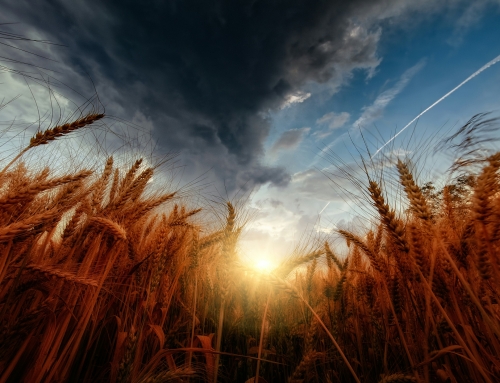Sermon Summary
The Garden Temple
The verses in Revelation. 21 tell us about the New Jerusalem. It is the new world which we seek to enter into, a beautiful garden. Where would you want to spend the rest of eternity? Wouldn’t such a garden be nice? It does not mean that we’re going back into the stone age, but it does sound nice. The book of Revelation is full of symbols and signs that communicate the spiritual significance of what is going to happen in the end. One such symbol is the idea of the New Jerusalem coming down from heaven as a bride adorned for her husband (Revelation 21:2). And in the following verse, we learn that it is a tabernacle (Revelation 21:3). It is a square city of 12,000 stadia, meaning that it’s around the size of Australia or India (Revelation 21:16).
The garden temple motif was already there since the beginning of the creation story. The garden of Eden was the result of God’s six days of creation work, but the Fall happened, and the inhabitants of the garden were kicked out. And now God wants to restore us back to the garden. The rest of redemptive history follows this pattern, especially the Tabernacle and various temples which image that very first garden. This is called “microcosm” or “microcosmos” where the thing itself represents the wider reality of the world. The whole universe is encapsulated in this small garden in Eden.
Tripartite Structure
A tripartite (three-part) structure recurs in the garden, the tabernacle, and temples in redemptive history. The garden has three parts: the outside of the garden, the place where all the trees are, and the tree of life. For the tabernacle and temple, there is the outer court, the holy place, and the holy of holies. When Jesus comes, He reconceptualizes the entire idea of a temple as a building: He is the true temple. As the Apostle Paul says, “your body is a temple of the Holy Spirit” (1 Corinthians 6:19). Our bodies also consist of three parts (1 Thessalonians 5:23). Jesus’ ministry also followed a tripartite structure in many ways. The prayer at the garden of Gethsemane images this: Jesus, His three disciples a stone’s throw away, and the rest of His disciples further away.
The outer court of the temple is described with dirt, dust, and mounds. The altar of burnt offering is placed atop a mound of dirt. Further inside the temple, there is a basin of water, called a “sea” (1 Kings 7:23-26; Ezekiel 43:14). The outer court is likened to the earth or mountain, and the sea. In the holy place, there are the golden lampstands, the table of showbread, and the altar of incense. These represent the visible sky. The golden lampstands had seven lights which represented the sun, moon, and stars. The holy place thus represents the visible heavenly realm. The holy of holies remains unseen beyond the holy place, and thus represents the spiritual heavenly realm. As the temple of God, all these things also bear significance for us.
The theme of flowing water
The theme of water flowing out of the temple also recurs throughout redemptive history. The garden of Eden had a river flowing from it (Genesis 2:10). Likewise, there is a stream of water flowing from Ezekiel’s temple (Ezekiel 47:2), and from the New Jerusalem (Revelation 22:1).
In order for us to be a true temple, we need to be where God dwells. Ezekiel’s temple is a place where God’s unique presence is. We need to also be like this. God walked in the garden of Eden (Genesis 3:8). The word for “walking back and forth” is mithallek”, which means that God’s presence is naturally there. This word recurs when describing God’s presence in the tabernacle (Leviticus 26:12; Deuteronomy 23:14-15). In order for God to dwell in our lives like this, we need to keep ourselves holy. Without God nothing can become holy, so we need to invite Him into our lives (2 Samuel 7:6-7). May we be like the New Jerusalem, where God dwells.
Concept of God’s rest (Sabbath)
The sabbath rest comes only after God creates and orders creation (Genesis 2:1-3). We learn about the idea of regency in the fourth book of the History of Redemption series. The heir to the throne, the next-in-line, becomes coregent with the current king in order to learn how to rule. This was the same with Adam and God in the garden of Eden. In the New Jerusalem, we will be the kings ruling over the world, and our God will enter His sabbath. In the garden of Eden, God gave Adam two commands in Genesis 2:15: Abad (to cultivate, to serve, to worship) and Shamar (to keep, to guard, to protect). And these verbs recur in the rest of the bible to describe the duties of the priests (Numbers 3:7-8; 8:25-26; 18:5-6; 1 Chronicles 23:32). The Targum (Aramaic) version of Genesis, translates Genesis 2:15 differently. It says, “to toil in the law and observe its commandments.”
Adam’s function was to keep the Word and guard it, but was he successful? If he was, the serpent should not have been able to enter into the garden of Eden. And because he did not teach Eve the Word correctly, Eve was deceived by the serpent. And so God places the cherubim to take over Adam’s duties (Genesis 3:24).
The commission and temple building
God created Adam in God’s image and commissioned him to be fruitful and multiply, to fill the earth and subdue it (Genesis 1:27-28). The purpose is to fill the earth with people full of God’s image, within which God’s sovereign rule is obeyed. Adam could not fulfil this, and so God gives this task to Noah (Genesis 9:1), to Abraham (Genesis 12:3; 17:2, 6, 8; 22:17-18), to Isaac (Genesis 26:3-4, 24), to Jacob (Genesis 28:3-4), and so on. And this commission has now been given to us. We are called to expand God’s territory and kingdom throughout the earth.
Conclusion
The bride in Song of Songs is described first as a locked-up garden (Song of Solomon 4:12). But later the bride is called a “garden spring” who is ripe for her husband (Song of Solomon 4:15-16). We need to become like this bride, ready for her husband. Our fruits need to be ripe. We need to be like the New Jerusalem (Isaiah 65:17; 66:22; Revelation 21:1). In order for us to transform into the New Jerusalem, we need to remove two things. There is no more sea (Revelation 21:1) and night (Revelation 21:23-27; 22:5). The sea symbolically points to the origin of cosmic evil, the unbelieving nations that rebelled against God and God’s people, the place of the dead, and the primary location of the world’s idolatrous trade activity (Revelation 18:10-19). It is this body of water that is no longer there in the New Jerusalem.
Secondly, there will be no night in the New Jerusalem (Is. 60:18-22). When we have God in our lives, we will no longer have spiritual night in our lives (John 11:10). When Judas went to betray Jesus, it was “night”. Psalm 139:11-12 says that even darkness is not dark to God. When God is in the picture, darkness and light are bright as day. May God illumine our lives as in the New Jerusalem (Rev. 22:5). May God take away the sea and the night from us.
Amen





